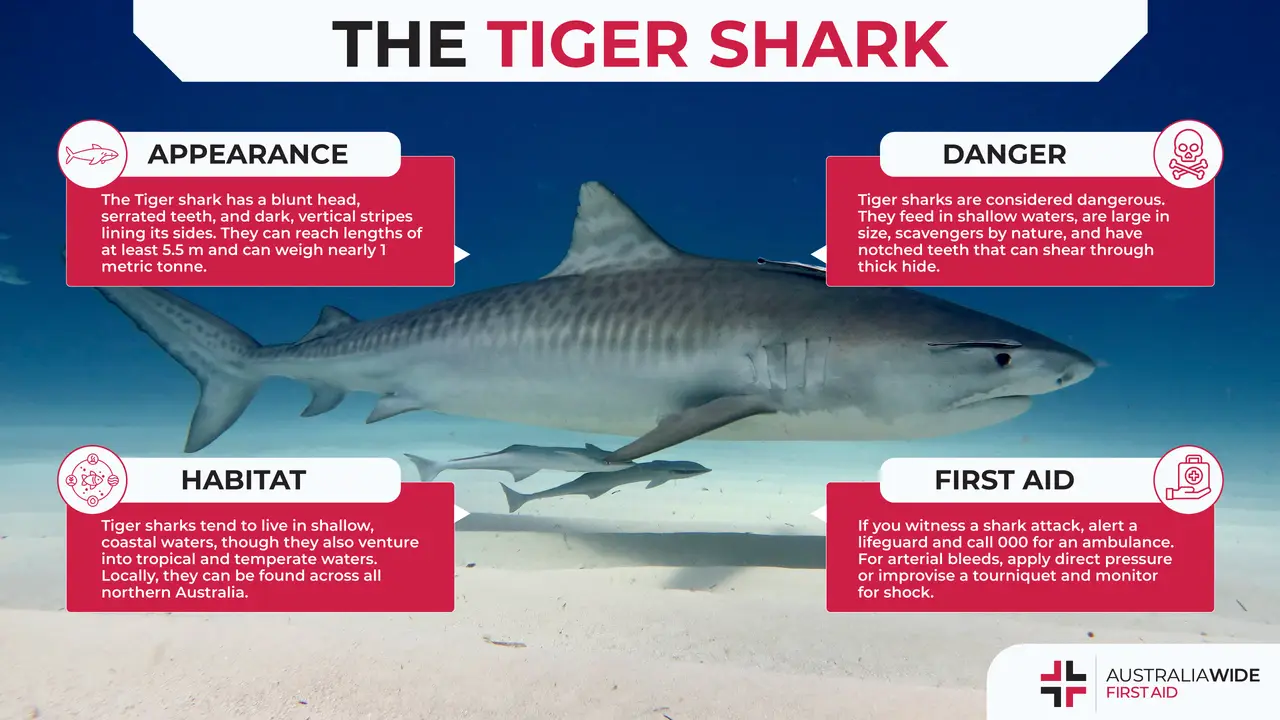Deadly Marine Life: The Tiger Shark


Australia is no stranger when it comes to shark attacks.
In 2020 alone, Australia recorded 22 unprovoked shark encounters, which accounted for more than 38% of the worldwide total. This is relatively unsurprising, given Australia has over 25,000 kilometres of coastline, and our waters are home to 170 of the world’s 400 shark species.
Our waters are also home to the 12 shark species that are known for unprovoked attacks, including the Great white shark, the Tiger shark, and the Bull shark – the 3 shark species that have been responsible for fatal attacks in the past 20 years.
Tiger sharks are particularly formidable predators, as they are large in size, are scavengers by nature, and are known to feed in shallow waters. In fact, National Geographic reports that Tiger sharks are second only to Great whites in the number of recorded attacks on humans.
As such, it is important to be wary of the Tiger shark – continue reading for an in-depth understanding of their behaviour and characteristics and the correct procedures for preventing and treating shark attacks.
The Tiger shark, or Galeocerdo cuiver, is the fourth largest shark and the second largest predatory shark in the world, second only to the Great white shark.
According to Oceana, they can reach lengths of at least 18 feet (5.5 m) and can weigh up to 2000 pounds (nearly one metric tonne).
Tiger sharks also have a blunt head, sharp, highly serrated teeth, and jaws that are powerful enough to crack the shells of sea turtles and clams.
Their most distinctive characteristic, however, are dark, vertical stripes covering the sides of their bodies. These stripes are most noticeable in juveniles and tend to fade or disappear as the shark matures.
Tiger sharks have a worldwide distribution, and though they tend to live in shallow, coastal waters, they are also known to venture into tropical and temperate waters.
In fact, Tiger sharks have been seen at depths of 1,150 feet (350 m).
In Australia, Tiger sharks can be encountered from Windy Harbour in south-western Western Australia and across the tropical north and south all the way to the southern coast of New South Wales.
Despite their exceptional senses of sight and smell, Tiger sharks are widely renowned for having what National Geographic describes as ‘a near completely undiscerning palate’.
These sharks are scavengers that have been known to feed on a wide array of both digestible and indigestible items, including fishes, small sharks, turtles, sea snakes, crustaceans, seabirds, marine iguanas, and assorted pieces of rubbish like license plates, car tyres, and fishing gear.
Because of their diverse appetite, Tiger sharks are also known to bite people to discern if they are a viable food source. And even if they decide against continuing with an attack, their first bite can be so large as to cause fatalities.
Tiger sharks are viviparous, which means they give birth to live young after a gestation period of between 12 to 16 months. On average, females produce litters of between 30 to 35 pups, though this number can be as low as 10 and as high as 80.
Juvenile Tiger sharks can generally be found in estuaries and protected bays, where they prey on coastal fish and invertebrates and escape from the cannibalistic tendencies of adult Tiger sharks.
Tiger sharks are regularly hunted for their skin, fins, and livers, the latter of which contains high levels of vitamin A that are processed into vitamin oil. For this reason, and because of their low repopulation rates, Tiger sharks are currently considered a ‘Near threatened’ species.

Tiger sharks are considered dangerous to humans.
Not only do Tiger sharks primarily feed in shallow waters, but they are also large in size, scavengers by nature, and have a mouth full of serrated teeth.
As such, they have a higher likelihood of encountering humans compared to deep-water shark species. And their immense size and notched teeth means that even one curious bite can inflict devastating damage.
There are several ways you can reduce your risk of a shark attack:
More tips for avoiding and surviving a shark attack can be found in our article on Shark Attack First Aid.
If you witness a shark attack, alert a lifeguard, make sure others are warned, and call Triple Zero (000) for an ambulance.
If you need to rescue the person from the water, use a boat as soon as it is safe to do so. Do not put yourself at risk if no lifeguard or boat is available.
Then:
A tourniquet is a tight band that can help stop or severely reduce the flow of blood around a wound. You can improvise a tourniquet using a surfboard leg rope, a belt with a buckle, or something similar.
Make sure to wrap the tourniquet high up the limb, tightly and horizontally.
More information about providing first aid in the event of a shark attack can be found in our Resource Library.
Films like Jaws might have you believing that Great white sharks are the most fearsome creatures in the water.
In reality, Great whites form part of a trio of sharks that are almost exclusively responsible for fatal attacks on humans in the past 20 years. Another member of this trio is the Tiger shark, which has a predilection for feeding in shallow waters.
They are also one of the largest sharks in the world and have notched teeth that can shear through the thickest of hides. As such, their encounters with humans can result in significant injuries.
It is important to remember, however, that shark attacks (while terrifying) are relatively rare - in fact, you are more likely to die from a hornet, wasp, or bee sting than from a shark attack.
Luckily, there are several ways you can reduce your risk of running into a Tiger shark. There are also multiple avenues for fending off a Tiger shark and treating any injuries you may sustain during an attack.
To develop even more knowledge and skills to keep yourself safe in the water this summer, book a First Aid course with Australia Wide First Aid today.

March 11, 2025
Darwin, the tropical capital of Australia’s Northern Territory, is home to a rich diversity of wildlife - including an impressive array of spiders. From the sprawling webs of golden orb-weavers to the cryptic camouflage of trapdoor spiders, these arachnids play a vital role in the local ecosystem. While some may inspire fear, the majority are harmless and even beneficial, helping to control insect populations.

September 4, 2024
Cat bites, while often underestimated, can lead to serious health complications if not treated promptly and properly. Cats' mouths harbour a variety of bacteria that can cause infections in humans.

April 1, 2024
Encounters with wildlife can often be thrilling, but when it comes to the creature known as the drop bear, the experience can quickly turn dangerous. A sharp increase in recent attacks prompts the need for understanding proper first aid procedures in case of an attack.